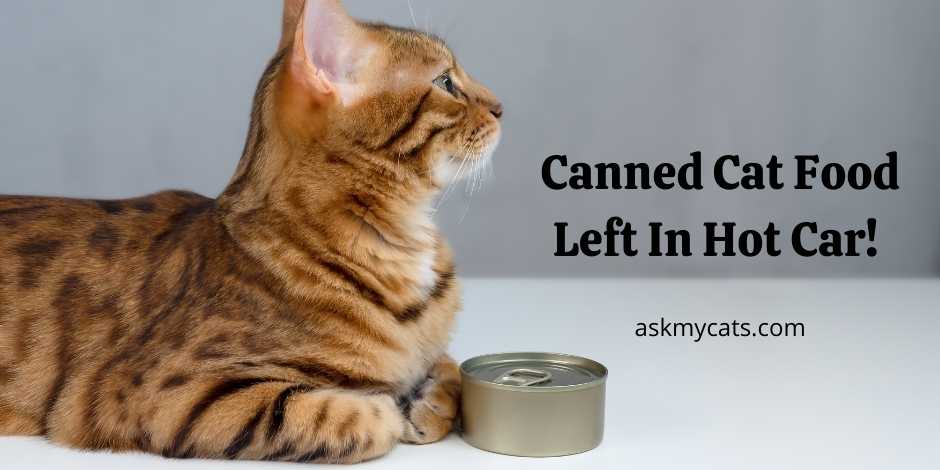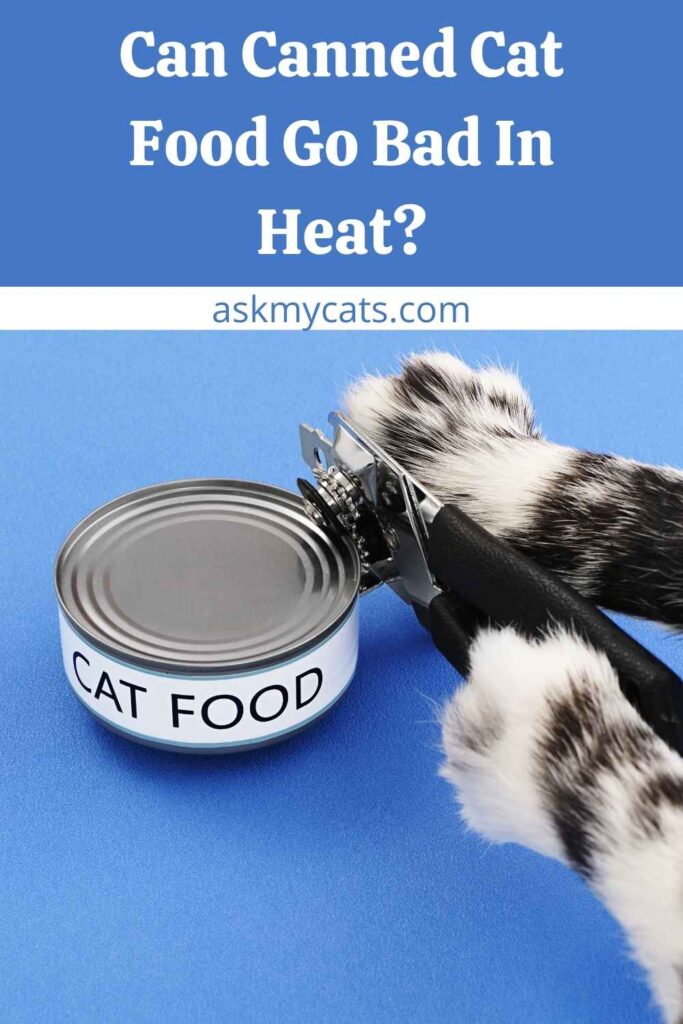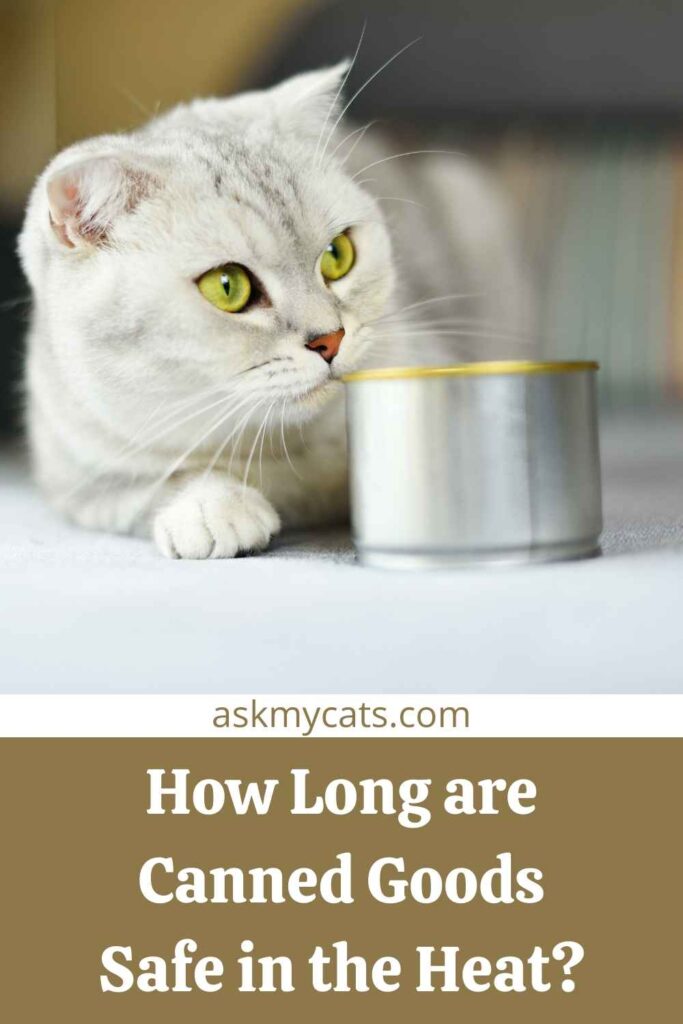It’s all too easy to leave something in the car after a trip to the shop, and if you’ve recently discovered some canned cat food, you might be wondering if you should feed it to your cat or whether you should throw it out and purchase some new food.
It’s not a good idea to keep canned cat food in a hot car for an extended period of time. This can affect the dish’s flavor, fragrance, and overall quality. While it is still healthy to consume, the cat’s taste buds may not like it.
This article will address the subject to understand better how heat affects canned cat food over time.


Give Your Cat the Perfect Day
Get the Free Ebook!
Can Canned Cat Food Be Left In A Hot Car?
Canned cat food shouldn’t be left in a hot vehicle for long periods.

Heat overexposure can affect the nutrients in the food, cause the container to explode, cause germs to thrive, and cook the meal.
It will usually be alright, but if the temperature has risen beyond 90 degrees Fahrenheit or you have been in the car for an extended period of time, you should be cautious.
It’s critical to get the right cat food for your cat, but that’s only one thing to consider. You must also know how to properly store dry cat food to maintain its nutritional content.
In the heat, dry cat food does not spoil. It will keep its nutrients as long as the heat is controlled and the food does not lose its physical integrity.
The cat will easily consume dry cat food that has been stored in heat. However, it is still a good idea to keep your cat’s food in a room temperature environment. This will guarantee that the cat chow matures properly and remains appetizing.
You must understand that cat food’s aging is influenced by more than simply the heat. It will be determined by the quantity of heat surrounding the dry cat food.
Of course, the dry cat food will not survive being placed in an oven. It’ll be charred to a crisp!
Due to the overall influence of the heat, there is a fair limit to how long dry cat food may be stored before it spoils.
Can Canned Cat Food Go Bad In Heat?
Yes, canned cat food can get bad in the heat.

Many people believe that canned food is indestructible and impossible to taint, regardless of the conditions.
However, we’ve all heard stories about canned food lasting for years, and it’s common knowledge that canned food is sterilized by being heated to extremely high temperatures while in the can.
You might be thinking about what might go wrong if the food is sanitary and the can is unharmed. Does excessive heat, for example, cause an issue with canned food?
There appears to be a lot of discussion regarding the topic, and while many people believe it is excellent, it is crucial to be aware of the hazards.
Cans should never be exposed to temperatures above 100 degrees Fahrenheit. Cans should be kept at a temperature of 84 degrees F or lower.
This pertains to human canned food rather than cat food, but it’s an excellent benchmark to use when prioritizing your cat’s health and ensuring that its food is safe. So, how hot does the inside of a car get?
It’s worth checking it out with a thermometer for yourself, but a car may reach 100 degrees Fahrenheit in the summer, even if the temperature outside does not reach that level. Cars may get exceedingly hot in direct sunlight with a sealed inside.
That implies your canned cat food may have reached a temperature of above 100 degrees Fahrenheit, and you should avoid giving it to your cat if this is the case. It may be alright, but it could also be disastrous, and you may not want to take the chance.
You might also like to check out how long does wet cat food last
How Long are Canned Goods Safe in the Heat?
Canned goods are safe for about one hour in the heat.

This is a fundamental shift that will be visible in canned cat food that has been stored in heat.
It will be warm, which might irritate a cat. Some cats, especially pets, are pretty picky about what they eat, which may affect how they feel about canned cat food.
You don’t want a situation where the cat is too hot to eat, causing them to flee oppositely or eat less than they should.
This is why, even if canned cat food does not go wrong, keeping it at room temperature is the best option.
It’s not a good idea to keep canned cat food in a heated environment. This entails placing it close to an oven and hoping for the best.
Canned cat food limits how much it can tolerate before it starts to burn. This will burn the meal to the point that it is no longer edible.
If stored at unreasonably high temperatures, the canned cat food will burn like other types of food would.
This is one of the ways that canned cat food can spoil.
The focus of this piece, on the other hand, is on essential heat that would be perceptible in warmer areas. Canned cat food should never be put in the oven!
The canned cat food is worthless if the cat doesn’t enjoy the flavor.
While canned cat food that has been stored in heat can still be consumed, the aftertaste may be unpleasant to the cat.
In general, it is noticed that cat food will alter in temperature.
This implies it will be edible, but the flavor will not be as fresh as if held at ambient temperature.
You might also like to read about how long does dry cat food last
Canned Cat Food Storage Temperature
In temperatures of 90 degrees Fahrenheit (32.22 degrees Celsius) or above, opened canned products are safe for one hour. On the other hand, Sealed canned products can withstand temperatures of above 140 degrees Fahrenheit (60 degrees Celsius) for two hours outside.
However, regardless of the status of the container’s seal, the danger of canned food deterioration increases dramatically when exposed to temperatures above 100 degrees Fahrenheit (37.78 degrees Celsius).
When canned goods are exposed to high temperatures for long periods, their acid or moisture content might react negatively, causing nutritional degradation.
Also, read about does wet cat food go bad if left out
How To Tell If Canned Cat Food Is Bad?
The canned cat food is definitely bad if the can has started bulging out and the food smells awful.
If you’re stumped and don’t believe the car could have reached that temperature, you might question what else you can look for. While evaluating the cans to see if they are safe for your cat, there are a few factors to consider.
If a can bulges or becomes deformed, it should be thrown away. This is most likely a sign that the can is no longer properly sealed, allowing bacteria to infiltrate the food. On the other hand, Cans should not lose their form, and bulges indicate a problem with the can or its contents.
Any large dents or cracks should be seen as an indication that the food within the can has been tampered with and is no longer safe to eat. A broken can qualifies as opened cat food if exposed to room temperature for more than twenty to thirty minutes.
Remove any cans that are clearly “open” due to a fracture or that have bulged and warped, as they may be broken in ways you can’t see.
If you have the opportunity, check the temperature of your automobile. The weather may have changed, making this unfeasible, but take advantage of it if you get the chance. This will give you better information about how likely the food is to be safe.
Remember that if the cans have been in the car for many days, the warmest day should be used as a reference because it is most likely to have spoiled the food.
Although cat food will never smell pleasant, this may be a decent (albeit not infallible) test if you can stomach it. Meat spoils quickly, and if the food within the cans has been tampered with, it may emit a foul odor.
Because humans are inclined to loathe the scent of decaying flesh as a method of preventing us from eating it and becoming unwell, it will most likely make you hurl.
To be clear, the lack of an unpleasant odor isn’t always an indicator that the item is safe to consume, as food-borne bacteria don’t always produce an odor. If it smells bad, though, you know it’s not safe to give your cat.
When in doubt, a call to the professionals might be beneficial. You may be able to get a phone number for the manufacturer, who should be able to tell you what temperature range their device is guaranteed to withstand. The majority of companies will have the information on their websites.
Alternatively, phone your veterinarian and inquire about the food’s suitability. Cat food is costly, and many households cannot afford to lose a whole stack of cans at once. While you don’t want to poison your cat, you should try a tiny bit of the food on it.
Your cat will most likely determine if the food is rotten and will reject it if it isn’t safe. Of course, you should not rely on this method as a fail-safe solution, but if you’re on a tight budget, it could be worth a go.
If the cat refuses the food, discard it and replace it with something new. Of course, it’s possible that the food is good and your cat is just being picky, but in such circumstances, it’s best to be safe than sorry!
Also, check out what to do if the cat ate spoiled wet food
Frequently Asked Questions
Can unopened canned cat food go bad?
With the assistance of chemical preservatives, canned cat food has a four-month to three-year shelf life when unopened and well packed. Open canned or wet cat food, on the other hand, will only survive five to seven days.
How Do You Know If Dry Cat Food Is Bad?
It has gone bad when dry cat food has a characteristic sour and/or bitter odor. Depending on the degree of exposure to an unstable storage environment, it may also attract pests and/or mold.
How long can you use canned cat food after the expiration date?
It’s usually accepted that you may give your dogs opened dry food three months beyond the “best by” date, but bear in mind that they won’t get all of the nutrients the food would typically contain. Use up any opened canned food that has been kept in the fridge within five to seven days of opening.
Final Words
No, it would be best not to leave cat food cans in a hot car. It should be fine if you accidentally did this on a warm or cold day, but if the temperatures have been really hot, the safest alternative is to discard the cat food and replace it with new.
While this may seem excessive, it’s preferable to accidentally give your cat something dangerous!
